One complaint originating from certain advocates about promoting self-defense training (typically in reference to women) is that ‘knowing” self-defense is no guarantee a person will be able to successfully prevent or interrupt an attack. Many times, this opinion is voiced from someone who claims to have implemented “self-defense” strategies, yet he or she was assaulted regardless. Therefore, self-defense training is deemed to be ineffective.
Does knowing how to swim prevent people from drowning? The uncontroversial answer to that question is – Yes. Knowing how to swim is an essential aspect of not drowning. The more people who know how to swim, the less people who end up drowning. Teaching people, particularly children, how to swim is an agreed upon societal method for reducing the risk of drowning.
That being said, knowing how to swim does not eliminate the risk of drowning. There have been an uncountable number of people who “know” how to swim yet still drown. People drown when the circumstances are such that they are unable to stop ingesting water. They drown when the adverse water circumstances exceeds their ability to swim.
The phrase “knowing how to swim” is a simplistic concept. People have varying swimming abilities from none to exceptional. But an exceptional swimmer can still drown when the circumstances exceed his or her swimming ability. Such circumstances may arise in the case of a swift moving current, a flood, a tsunami, very cold water, very hot water (natural hot springs), underwater obstacles, an injury, drunkenness, entrapment, the list goes on. People drown all the time from circumstances beyond their control. Sometimes people drown in a bathtub after they slip, fall and are knocked unconscious.
In fact, many times people’s very confidence in their swimming abilities gets them into trouble. They think they can swim better than they really can. They are great swimmers in a sunny 75 degree pool, but they panic and thrash about when they fall into a muddy river fully dressed during the nighttime. Every year shoreline ocean waves claim the lives of numerous people who overestimated their swimming ability.
Upon short reflection, it is easy to see that knowing how to swim is no guarantee for not drowning. But that is not the point. It is not the point because teaching people how to swim and about water safety is an effective means for society to systematically reduce incidents of drowning. It is an effective means for an individual to reduce his or her chance of drowning.
And self-defense is no different that swimming. People have vary abilities of self-defense knowledge and capability from minimal to exceptional. Their self-defense ‘fails” when the circumstances of the assault exceeds their ability to handle it. For a person with very low self-defense knowledge and capability, this threshold could be exceeded by almost any aggressive person. But for others, only the most motivated attacker(s) or extreme circumstances will cause their demise.
As in swimming, sometimes people are overconfident about their self-defense capability. This confidence leads them to take risks that exceed their ability to handle the situation. Their actual knowledge was less then they realized.
Who are the people who claim that self-defense is actually ineffective? Who are the people spreading personal stories of self-defense “failures” designed to prove that self-defense training doesn’t work? My guess is that the majority of these people have a low knowledge and capability of self-defense. In terms of the swimming analogy, they know how to swim. They can handle the backyard pool, but they are ill prepared for any threatening water situations other than that. Their knowing self-defense is little more than fearfully implementing simplistic risk reduction strategies such as “don’t walk down dark alleys” and “stay away for creepy looking people.” And rather than acknowledge their personal ineffective level of self-defense knowledge and capability, they are on a mission to label all self-defense training for all people as ineffective.
If they truly “knew” self-defense, they would understand that self-defense knowledge and capability requires combining risk reduction strategies with environmental knowledge, effective boundary setting, good judgment, and the skills to prevent, interrupt, and mitigate a wide variety of threats with the goal of minimizing negative consequences with whatever means are available.
Which brings me to the conclusion of this piece. Teaching swimming with all its inherent flaws is considered an acceptable means for reducing incidents of drowning. But why is teaching self-defense subject to angry outcries of ineffectiveness combined with accusations of self-defense training actually being a form of Victim-Blaming? In my opinion, it is because the existence of self-defense training as an additional means to reduce interpersonal violations is a threat to the ideology that promotes agenda driven social engineering as the one and only solution to said problem.
Related:
Seven Ways Women’s Self-Defense Teaches Men Not to Rape Hyper-Advocates and Two Types of Problem Solving Methodologies Blame and Responsibility Are Not Mutually Exclusive Victim Factoring is Not Victim Blaming

Their vaccination services are quick and easy.
can you buy generic lisinopril price
A true champion for patients around the world.
**provadent**
provadent is a newly launched oral health supplement that has garnered favorable feedback from both consumers and dental professionals.
**nitric boost ultra**
nitric boost is a daily wellness blend formulated to elevate vitality and support overall performance.